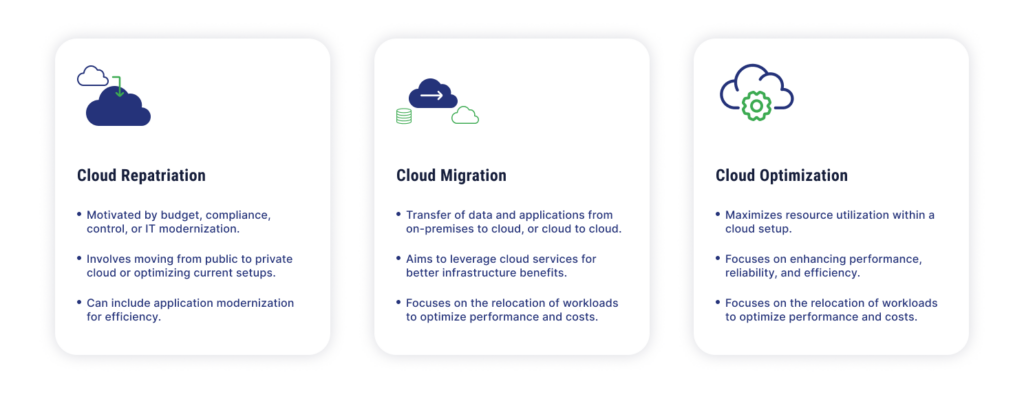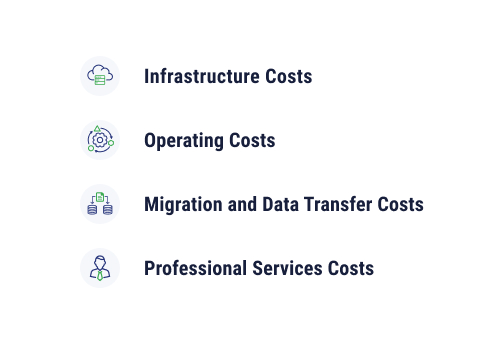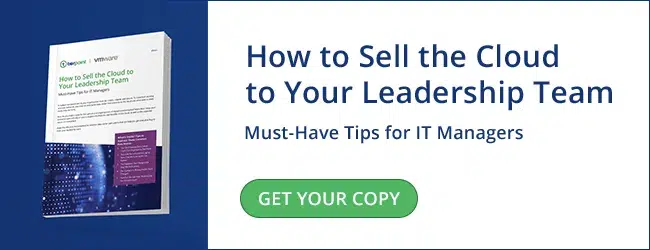
While 87% of organizations are using multicloud environments for their data and applications, some businesses are choosing to move some or all of their workloads back to on-premises or colocation environments, in a move that is called cloud repatriation. It’s important to remember that repatriation doesn’t have to be all-encompassing. In fact, it can be done as part of a hybrid cloud strategy, something that 72% of businesses are embracing. So, what is cloud repatriation, where may it be necessary or beneficial, and how can businesses choose between cloud repatriation or a balanced hybrid cloud approach?
What is Repatriation in Cloud Computing?
Cloud repatriation involves moving applications or workloads that were once on a public cloud environment either back on on-premises infrastructure, colocation infrastructure, or to a different cloud environment with an alternative cloud services provider. This can be viewed as a tactical adjustment in the deployment strategy, allowing organizations to optimize their IT infrastructure based on evolving business needs and priorities.
Cloud Repatriation vs Cloud Migration vs Cloud Optimization: What’s the Difference?
While it may seem like cloud repatriation is simply the reverse of cloud migration, the scope of this movement is more varied. Cloud repatriation may be done due to budgets, compliance requirements, a desire for greater control, or as a broader IT modernization project. For instance, repatriation could entail transitioning from a public cloud to a private cloud environment while simultaneously modernizing applications to achieve better control and efficiency. This multifaceted nature sets cloud repatriation apart from both cloud migration and cloud optimization.
Cloud migration involves the transfer of applications and data from on-premises infrastructure to cloud environments, or possibly from one cloud service provider to another. This relocation typically aims to leverage the advantages offered by specific cloud services and infrastructure.
On the other hand, cloud optimization focuses on maximizing resource utilization within a cloud environment, whether it’s public or private. Rather than relocating workloads, optimization initiatives concentrate on enhancing performance, reliability, and resource utilization within the existing cloud setup.

Why Are Businesses Considering Cloud Repatriation?
Businesses that choose cloud repatriation may do so for one of a few reasons, including cost, security, compliance, and performance.
Cost
Resource-intensive workloads often drive up cloud storage expenses, particularly in the absence of careful planning. Incorporating a comprehensive cloud workload strategy that accounts for the cost disparities between on-premises and cloud environments is crucial. This strategic approach enables businesses to evaluate whether repatriating certain workloads to on-premises environments could yield significant cost savings.
Security
While public cloud providers like AWS include robust security features, including state-of-the-art data centers and stringent physical and network security protocols, the responsibility for data and application security primarily lies with the businesses themselves. Despite the providers’ efforts in maintaining security standards, organizations may find themselves desiring more granular control over security configurations than what is feasible in the cloud. This discrepancy in control prompts some organizations to opt for cloud repatriation, allowing them to regain greater autonomy over security measures by hosting critical data and applications on-premises.
Compliance
New compliance measures can change the specifications for certain workloads, making it hard or impossible to store data in the public cloud. Because of this, some businesses may be forced to repatriate to an on-premises environment.
Performance
Latency-sensitive workloads can benefit from on-premises infrastructure, which, when configured well, can offer improved performance.
Challenges of Cloud Repatriation
Just like cloud migration, cloud repatriation can be a time-consuming and complicated process and can come with several challenges.
Complexity
While it’s not always a complete reversal of cloud migration, cloud repatriation is a complex process that operates much like a cloud migration. All dependencies and configurations that were created in the cloud need to be considered before moving to a colocation or on-premises environment. The plan for cloud repatriation needs to be well thought-out just like migration.
Cost
Whether cloud repatriation saves a business money more than keeping workloads in the cloud depends on the data and applications being stored and moved, and the amount of resources a business uses.
While repatriation may appear to offer potential savings compared to cloud, businesses must carefully evaluate the total cost of ownership (TCO) to determine its viability. Organizations looking to lower their cloud costs through repatriation should also be mindful that the move will mean they need to incur new expenses, such as maintaining hardware infrastructure, software licenses, and the on-premises environment itself. Additionally, operational costs related to managing and securing the infrastructure, as well as potential costs associated with scaling or upgrading, should be factored into the equation. So, it’s essential to conduct a thorough cost-benefit analysis, considering both short- and long-term implications, to make informed decisions about cloud repatriation.
Flexibility
One of the biggest benefits of a public cloud environment comes from the flexibility and scalability offered through cloud computing. On-premises frameworks have less flexibility compared to the public cloud, which means that scaling resources up or down as needed can become more challenging. With that, businesses need to assess the impact of repatriation on their agility and flexibility when considering this approach.
Factors to Consider Before a Cloud Repatriation
Moving to and from the cloud isn’t a move that should be made without a lot of thought, so here are a few questions IT decision-makers should ask before choosing cloud repatriation for one or more of their workloads.
What Are Your Business Reasons for Repatriation?
Chances are, you’re considering cloud repatriation because you’re trying to solve a specific business problem. Some common motivators that may spur the desire for cloud repatriation include:
- Cost Optimization: Are public cloud expenses outweighing the cost-savings benefits you hoped to get from the cloud? Are even predictable workloads exceeding your budgets?
- Performance: Are there latency-sensitive applications that need more dedicated resources than what can be provided in a public cloud environment?
- Security and Compliance: Are there security and compliance requirements that you aren’t able to meet in a public cloud environment, or may be too expensive to address in the public cloud?
What Are the Associated Costs?
Avoiding cloud bills is on one side of the coin, but understanding associated costs with cloud repatriation is on the other.
Infrastructure costs include the purchase of hardware, software, and data center space, whether you’re running your own data center or moving to a colocation environment.
Operating costs can apply to power, cooling, maintenance, and staffing required to keep on-premises infrastructure moving.
Migration and data transfer costs should also be included in your estimate, even if they’re only one-time expenses. Professional services fees, application reconfiguration, and down-time ought to be included in this cost as well.

How Will Performance Be Impacted?
Some workloads are more suited for the cloud, while others perform better in on-premises environments. The key consideration lies in assessing factors such as network latency and resource availability when contemplating cloud repatriation. While on-premises data centers can often offer lower latency, particularly for localized operations, the global reach of public cloud infrastructures can be advantageous for serving geographically dispersed users. Additionally, certain workloads require dedicated resources, where performance may be optimized in on-premises environments.
Do You Have the Right Skills On-Staff?
Managing an on-premises infrastructure means that you will need more in-house expertise, or will need to call in outsourced reinforcements, to fill the gaps that were previously covered by your public cloud provider. These skills can include system administration, cybersecurity experience, and application support. You’ll need to ensure your staff can maintain hardware, software, and networking, as well as anticipate and combat any incoming threats. You’ll also need help on-hand that can manage applications and troubleshoot issues.
Other Considerations
Before you engage in cloud repatriation, you’ll also want to think about your strategies for data and ensure your on-premises environment meets your regulatory requirements. It’s also important to remember that repatriation isn’t an all-or-nothing endeavor. You may want to consider a hybrid approach, leaving some workloads in the cloud, while moving others back to an on-premises or colocation environment.
Cloud Repatriation Alternative: The Benefits of Adopting a Hybrid Cloud Strategy
When compared to cloud repatriation, a hybrid cloud strategy can be more flexible, cost-effective, and simple, among other things.
Flexibility
A hybrid approach allows you to utilize different environments based on their strengths. For instance, the public cloud is ideal for workloads with fluctuating resource demands, while private cloud environments are better suited for sensitive data and mission-critical applications that require more control. For added flexibility, managed cloud services like Managed Azure Stack can be a great option. These services extend Azure’s cloud capabilities across both public and private environments, all managed within a TierPoint data center, providing valuable support for businesses dealing with the complexities of cloud repatriation.
Cost Optimization
Placing the right workload in the proper environment can also save on costs, allowing you to pay more predictable amounts for consistent workloads and burst resources to the public cloud when there are unexpected surges. Cloud services can also be more cost-effective and can be leveraged more easily in a hybrid approach.
Performance
Instead of worrying about balancing low latency for local users with the global reach of cloud, a hybrid approach gives you the best of both worlds. Workloads can be distributed in a way that maximizes performance for the most mission-critical applications.
Security and Compliance
Major cloud providers offer advanced security features, but they may not be enough for sensitive data and applications, which would be better suited to on-premises environments. Hybrid cloud means you can have stricter controls on some data, while taking advantage of public cloud security controls for other data.
Reduced Complexity
Full repatriation is a complex process. Anything less than full-scale migration will reduce the complexity involved in cloud repatriation. Only move the workloads that make sense to move and enjoy fewer disruptions and lower risk by considering a hybrid approach.
Access to Innovative Tools
When taking a hybrid cloud approach, organizations can harness the power of cutting-edge public cloud tools and services within their environment that may not be readily available through other solutions. By integrating public cloud services into hybrid infrastructure, businesses can access a wide array of innovative tools, such as advanced analytics platforms, scalable storage solutions, artificial intelligence and machine learning (AI/ML) processes, and Internet of Things (IoT) solutions.
Leverage TierPoint’s Managed Cloud Services to Navigate Your Cloud Repatriation or Hybrid Cloud Journey
If you’re wondering whether cloud repatriation or hybrid cloud is better, the answer truly depends on your business goals, needs, and capabilities. You’ll want to ask yourself whether cloud repatriation is the answer to your cloud challenges, or whether a hybrid cloud approach can provide the perfect middle-ground between total repatriation and complete reliance on one cloud provider.
Whichever direction you’re considering, TierPoint can help you figure out your ideal path and get you moving. Learn more about our cloud solutions and consulting services today. Need help getting executive buy-in for your approach? Download our eBook to gain the insights you need to make a compelling case for digital transformation.

